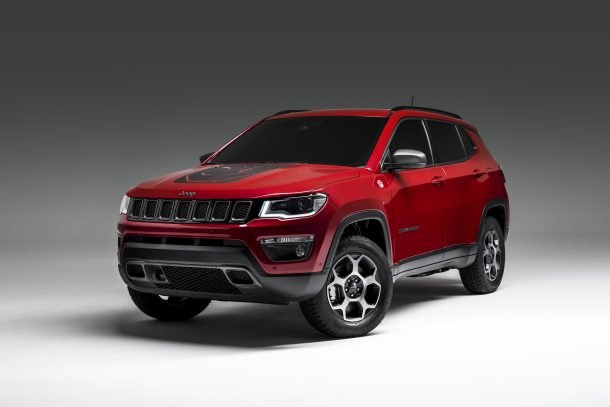Jeep's Green Wave Crashes Into Europe, Will Ripple Back to North America

Fiat Chrysler’s reputation as an automaker that scoffs at fuel economy mandates is slowly being chipped away. Never mind the much-loathed Fiat 500e; it was the Chrysler Pacifica Hybrid that really got the ball rolling, with eTorque-engined Ram 1500s upping the company’s green cred for 2019.
At this week’s Geneva Motor Show, the high-flying Jeep brand revealed the next salvo in its bid to lower corporate emissions while wooing eco-conscious (or heavily taxed) overseas buyers: Two crossovers, each bearing a plug-in hybrid drivetrain.
While American consumers can expect a plug-in Wrangler hybrid sometime in 2020, Jeep’s Tuesday reveal focused on more Euro-friendly models. The subcompact Renegade and compact Compass both gain a plug-in hybrid system that mates a rear-mounted electric motor with the brand’s potent new 1.3-liter turbocharged four-cylinder.
Debuting in the 2019 Compass, the gasoline engine makes 177 hp and 200 lb-ft of torque in U.S.-spec models. For these two plug-ins, FCA claims a combined output of 190 to 240 hp, with the Compass understandably earning the highest power figure.
All-electric range for both Renegade and Compass is 31 miles, with each vehicle said to be capable of 80 mph in EV mode and a seven-second 0-62 mph sprint. The Renegade and Compass PHEV mark the debut of Jeep’s eAWD system, which forgoes a mechanical connection between front and rear drive wheels.
“Thanks to the new electric all-wheel-drive technology (eAWD), traction to the rear axle is not provided by a prop shaft but through a dedicated electric motor,” FCA said. “This allows the two axles to be separated and to control the torque independently in a more effective way than a mechanical system.”
In last year’s five-year plan, the automaker said it hoped to offer 12 electrified powertrains globally by 2022, split among mild hybrids, hybrids, plug-ins, and fully electric vehicles. North America is said to get eight Jeep plug-ins by that target year, so expect to see this duo offered stateside, probably by the end of next year. The automaker has already revealed the Renegade PHEV’s availability in early 2020.
Last week’s plant investment announcement saw FCA reveal the future production of four PHEVs on American soil, as well as capacity for BEVs. Sitting atop Jeep’s green pyramid will be the plug-in Wagoneer and Grand Wagoneer.
[Images: Fiat Chrysler Automobiles]

More by Steph Willems
Latest Car Reviews
Read moreLatest Product Reviews
Read moreRecent Comments
- Probert They already have hybrids, but these won't ever be them as they are built on the modular E-GMP skateboard.
- Justin You guys still looking for that sportbak? I just saw one on the Facebook marketplace in Arizona
- 28-Cars-Later I cannot remember what happens now, but there are whiteblocks in this period which develop a "tick" like sound which indicates they are toast (maybe head gasket?). Ten or so years ago I looked at an '03 or '04 S60 (I forget why) and I brought my Volvo indy along to tell me if it was worth my time - it ticked and that's when I learned this. This XC90 is probably worth about $300 as it sits, not kidding, and it will cost you conservatively $2500 for an engine swap (all the ones I see on car-part.com have north of 130K miles starting at $1,100 and that's not including freight to a shop, shop labor, other internals to do such as timing belt while engine out etc).
- 28-Cars-Later Ford reported it lost $132,000 for each of its 10,000 electric vehicles sold in the first quarter of 2024, according to CNN. The sales were down 20 percent from the first quarter of 2023 and would “drag down earnings for the company overall.”The losses include “hundreds of millions being spent on research and development of the next generation of EVs for Ford. Those investments are years away from paying off.” [if they ever are recouped] Ford is the only major carmaker breaking out EV numbers by themselves. But other marques likely suffer similar losses. https://www.zerohedge.com/political/fords-120000-loss-vehicle-shows-california-ev-goals-are-impossible Given these facts, how did Tesla ever produce anything in volume let alone profit?
- AZFelix Let's forego all of this dilly-dallying with autonomous cars and cut right to the chase and the only real solution.




































Comments
Join the conversation
One question though: "Debuting in the 2019 Compass, the gasoline engine makes 177 hp and 200 lb-ft of torque in U.S.-spec models. For these two plug-ins, FCA claims a combined output of 190 to 240 hp, with the Compass understandably earning the highest power figure." --- Why would the Compass, being bigger and heavier (albeit not by much) get, "...understandably ... the highest power figure"? If they're using the same engine and the same eHybrid drive, they should get almost identical figures. When comparing the gasoline-only versions, the Compass actually realizes a slight reduction in economy compared to the Renegade despite the Renegade's less-aerodynamic nose.
Makes me wonder how they integrate the output of the elctric motor in back and the ICE up front. With mechanical AWD you get automatic correlation of front and rear axles. That's why Subaru kept its AWD system in their new hybrid. And no Mr Vulpine, I need no theorizing from you. Nothing I've read from you gives me any confidence you know what you're on about, and you're opinionated with it. I'm a mechanical engineer, so if you have some idea to fulminate upon, make it logical and defensible.